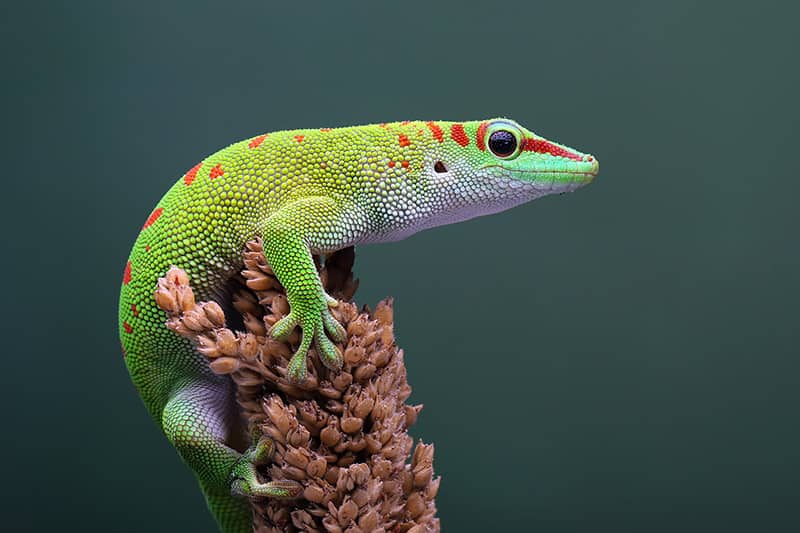Identifying different types of lizards is easy because most have a strong family resemblance!
Pet lizards and lizard species in general are often described by their family, or a common name descriptive of their family. Most lizard families contain various groups of lizards tied together by anatomical similarities, Many common lizard species are often simply referred to as Agamas, Chameleons, Geckos, Iguanas, Monitors, Skinks, Tegus, and a few others. The lizard in the picture above is easily recognized as a Chameleon. Only Chameleons have those crazy bulging eyes that swivel around in all directions, and those curious feet.
Lizard classification is part of a natural classification system used by taxonomists. This classification system was devised by Swedish biologist Carl Linnaeus in the late eighteenth century. He is credited for the beginnings of this system as a way of arranging plants and animals into groups based on differences and similarities between them. Linnaeus is often called the ‘Father of Taxonomy’. The system currently used by taxonomists is called the Linnaean taxonomic system, in his honor.
The Linnaean classification system has a hierarchy of seven main taxonomic ranks, defined by the international nomenclature codes. These ranks are kingdom, phylum, class, order, family, genus, and species. This system is very dynamic. The groupings, and the principles behind the groupings, have significantly changed since their conception and continue to change and expand, as more information is being assimilated.
In this guide, the lizard classification section outlines the main taxonomic ranks, from the kingdom down to the lizard families. There are currently about 27 lizard families, based on traditional classification, described as well. Each of these sections has a list of all types of lizards that may be found for pets, as well as many other species.
- For information on keeping lizards as pets, see: Reptile Care: Keeping Reptiles and Amphibians as Pets
Cool Pets! Reptiles
Lizard Classifications
Lizards belong to a large class of animals called Reptilia, which contains over 8225 species. Reptiles are animals that are ectothermic (cold-blooded) vertebrates that breathe air. Most reptiles are oviparous (egg-laying) animals with the exception of some ovoviviparous (live-bearing) constrictor snakes and vipers, as well as a few lizard species. They are also tetrapods, vertebrate animals that have four limbs or are descended from animals with four limbs.
Deciphering the lizard classification system can at first seem like a daunting task. To the non-scientific mind lizard taxonomy is like a maze constructed of a bunch of unfamiliar, Latin-based terms that lead this way and that. But it’s the lizard itself, whose physical, anatomical features solve the mystery of the maze. Answering a simple question about the lizard at each juncture, from the kingdom down, leads through all the twists and turns of the lizard’s family. And finally, within the lizard families, you can find the individual species, which is your lizard.
To follow the lizard classification hierarchy, the predominant taxonomic ranks are highlighted. It starts with the largest number of animals in the top rank, the kingdom, and then moves sequentially down to smaller and smaller subsets. These include the subkingdom, phylum, superclass, class, subclass, order, suborder, and family. Notes are included about new classification expansions and inclusions of additional ranks where appropriate. The additional ranks are inset.
Kingdom: Animalia or Metazoa
- Subkingdom Eumetazoa
The kingdom contains two subkingdoms (the other being Subkingdom Parazoa Porifera). The kingdom is then divided into Superphylums, the Superphylum containing the lizards is:- Superphylum: Deuterostomia
- Phylum: Chordata
The phylum Chordata contains three subphyla, with Subphylum Vertebrata containing the lizards and the other two being; Subphylum Tunicata (Urochordata) and Subphylum Cephalochordata (Acraniata).- Subphylum: Vertebrata (Craniata)
These are vertebrates, animals with backbones, with approximately 58,000 species.
Note: In traditional classification, the path would then move directly from here to the Class Reptilia (reptiles). But as the study of animals has evolved, there are additional developments in refining classifications at this point, particularly for reptiles and amphibians. Under the Subphylum Vertebrata, reptiles can then be placed in the following Infraphylum:- Infraphylum: Gnathostomata
This infraphylum is defined as vertebrates with jaws.
- Infraphylum: Gnathostomata
- Subphylum: Vertebrata (Craniata)
- Superclass: Tetrapoda
Tetrapoda means four-limbed vertebrates, this rank currently contains about 28,000+ species. - Class: Reptilia (reptiles)
Class Reptilia contains over 8,225 species.
Note: As tetrapods, in newer classifications, they are associated with the clade Amniota. These are animals that have a terrestrially adapted egg and includes mammals, reptiles, and birds. Birds and mammals are distinguished with the subclades, Mammalia and Aves respectively, but reptiles are not so distinguished. Reptiles are sort of just out there. Lacking feathers and fur, it could just be said they are ‘non-avian, non-mammalian amniotes’.
Note: As reptilia, in newer classifications they are associated with the clade Eureptilia (“true reptiles”). This is one of the two major clades of the Sauropsida (“lizard faces”), with the other being Theropsida (“beast faces”), This is a group of amniotes that includes all existing reptiles and birds and their fossil ancestors, including the dinosaurs.- Subclass: Diapsida
These are reptiles that have developed two holes (temporal fenestra) in each side of their skull. This group contains most of the reptiles, including lizards, snakes, crocodilians, dinosaurs and pterosaurs
- Subclass: Diapsida
- Order: Squamata
The Squamata order contains the scaled reptiles, animals distinguished by their skin being covered with horny scales or shields. There are currently about 7,900 species. Here we are using the current ITIS taxonomical hierarchy where the Squamata order has five suborders. It is structured with four suborders that contain lizards, and a fifth that contains snakes (Suborder Serpentes) so won’t be covered here. We also expanded this to include the Suborder Sauria containing the unique Burrowing Lizards and Burrowing Slow Worms.- Note: In traditional classification, the Squamata order had three suborders: Lacertilia containing the lizards, Serpentes containing the snakes, and Amphisbaenia containing the worm lizards. Then later the Lacertilia suborder itself contained the four generally recognized suborders; Iguania, Gekkota, Amphisbaenia, and Autarchoglossa.
- Note: In newer classifications the name Sauria is a clade that is used for reptiles and birds in general, and the Squamata are divided differently. But more recently it has been discovered that a couple other groups are now known to have venomous lizards.
- Note: Part of this re-classification is due to the discovery that more lizards are venomous than were previously thought. It had long been thought that only the Gila Monsters and the Beaded lizards, in the Family Helodermatidae, were venomous lizards. One group contains the monitor lizards of the Family Varanidae, like the Komodo dragon Varanus komodoensis. The other contains lizards in the Suborder Iguania from the Family Agamidae, like the Bearded Dragon, and from the Family Iguanidae, like the Green Iguana.
- Much of the re-classification is being scrutinized and adjusted, so at this time we are primarily using the ITIS taxonomical hierarchy, with two exceptions. One exception is to Includes the Suborder Sauria with the unique Burrowing Lizards and Burrowing Slow Worms. The other exception, we will keep the earlier subfamily structure under Family Iguanidae, rather than making each of these subfamilies into families as ITIS does. The structure of these being families vs. subfamilies is one of the highly debated areas.
- Suborder: Amphisbaenia
Amphisbaenia contains the worm lizards:- Family: Amphisbaenidae
Tropical worm lizards, amphisbaenid with 5 species. - Family: Bipedidae
Ajolotes with 6 species. - Family: Rhineuridae
North American worm lizards with 7 species. - Family: Trogonophidae
Palearctic worm lizards with 8 species.
- Family: Amphisbaenidae
- Suborder: Autarchoglossa
Autarchoglossa contains an interesting variety of lizards from legless species, skinks and monitors, whiptails, racerunners and night lizards, to the two venomous lizards, the Gila Monster and The Beaded Lizard- Family: Anguidae
Alligator Lizards, Anguid Lizards, Galliwasps, Slow Worms, Glass Lizards consisting of 94 species in 3 subfamilies, and 9+ genera- Subfamily: Gerrhonotinae
Alligator lizards - Subfamily: Anguinae
Slow worms and Glass lizards - Subfamily: Diploglossinae
Galliwasps
- Subfamily: Gerrhonotinae
- Family: Anguidae
Alligator Lizards, Anguid Lizards, Galliwasps, Slow Worms, Glass Lizards consisting of 94 species in 3 subfamilies and 9+ genera - Family: Anniellidae
Legless Lizards consisting of 2 described species in 1 genera - Family: Cordylidae
Girdle-tailed Lizards, currently consist of about 71 species in 4 genera.- Subfamily: Chamaesaurinae
- Subfamily: Cordylinae
- Family: Gerrhosauridae
Plated Lizards consist of about 34 species in 6 genera.- Subfamily: Gerrhosaurinae
- Subfamily: Zonosaurinae
- Family: Gymnophthalmidae
Spectacled lizards, with 100’s of different species (possibly 2000+) in about 52 genera - Family: Helodermatidae
Venomous Lizards, the Gila Monsters and Beaded Lizards with 2 described species in 1 genera, though with a few suggested subspecies. - Family: Lacertidae
Typical Lizards, Wall Lizards, Lacertid Lizards, Old World Runners, with hundreds of species in 37 genera- Subfamily: Gallotiinae
- Subfamily: Psammodromus
- Family: Lanthanotidae
Earless Monitor Lizard, with just 1 described species in 1 genera - Family; Scincidae
Skinks, with about 1200 described species in many genera (many are being re-classified) - Family: Teiidae
Tegus and Greaved Lizards, Ground Lizards, Ameivas, New World Runners, Racerunners, Whiptails are estimated at approximately 400 species in about 40 genera. - Family: Varanidae
Monitor Lizards, with over 70 species in 1 genera, at least 62 species are described
- Family: Anguidae
- Night Lizards, with approximately 23 living species in 3 genera
- Family: Xenosauridae
Crocodile Lizards, Strange Lizards, Earless Monitor Lizards, Knob-scaled lizards with about 5 species in 2 genera- Subfamily: Shinisaurinae
Crocodile Lizards - Subfamily: Xenosaurinae
Strange Lizards, Knob-scaled lizards, Earless Monitor Lizards
- Subfamily: Shinisaurinae
- Suborder: Gekkota
Gekkota contains all the geckos and the limbless, snake lizards in the Pygopodidae family.- Family: Carphodactylidae
Australian knob-tail geckos consist of 29 described species in 7 genera. - Family: Diplodactylidae
Stone geckos currently consists of about 118 described species in 19 genera. - Family: Eublepharidae
‘Eyelid’ geckos, Eublepharid Geckos, about 30 species in 6 genera. - Family: Gekkonidae
Geckos, wide variety of Geckos, over 2000 different species in 52 genera. - Family: Phyllodactylidae
Leaf-toed, Turnip-tailed, Wall geckos, currently consists of 117 described species in 11 genera. - Family: Pygopodidae
Legless lizards, Snake lizards, Flap-footed Lizards, consists of 41 described species in 7 genera. - Family: Sphaerodactylidae
Bent-toed, Dwarf geckos, there are over 200 described species in 11 genera.
- Family: Carphodactylidae
- Subkingdom Eumetazoa
- Suborder: Iguania
Iguania are primarily tree-dwellers, and this group contains a number of the best known pet lizards, including the Iguanas, Chameleons, Anoles, and Agamids, as well as the Chuckwallas. The Iguania suborder is definitely one of the largest groups of lizards, consisting of 3 families and over 1000 species. This group also contains a number of the best known pet lizards, including the Iguanas and Anoles as well as Chameleons and Agamids. Many of the species are considered “New World” lizards because they are found mostly on the Americas. These are found from southern Canada in North America to the tip of South America and on the islands of Fiji and Madagascar.- Family: Agamidae
Old world arboreal lizards of more than 300 species with 6 subfamilies generally recognized.- Subfamily: Agaminae
Bearded Dragons, Water Dragons, and Agamas (Africa, Asia and Australia) - Subfamily: Amphibolurinae
(Australia and New Guinea) - Subfamily: Draconinae
(South and Southeast Asia) - Subfamily: Hydrosaurinae
Sailfin Lizards (Hydrosaurus, Papua New Guinea, Philippines, and Indonesia) - Subfamily: Leiolepidinae
Butterfly Lizards (Leiolepis, Southeast Asia) - Subfamily: Uromasticinae
Uromastyx or Spiny-tailed lizards (Saara and Uromastyx, Africa and south Asia)
- Subfamily: Agaminae
- Family: Chamaeleonidae
There are approximately 160 Chameleons species from 2 subfamilies, containing 11 genera- Subfamily: Chamaeleoninae
- Subfamily: Brookesiinae
- Family: Iguanidae
American arboreal lizards, chuckwallas, iguanas, iguanids, with at least 33 living species in 8 genera.- Subfamily: Corytophaninae
Helmet lizards or Casquehead lizards with 9 known species from 3 genera. - Subfamily: Crotaphytina
Collared lizards or Leopard lizards with 12 species in 2 genera. - Subfamily: Hoplocercinae
Wood lizards, Club-tail Lizards (also called Dwarf Iguanas) with 10 described species in 3 genera. - Subfamily: Iguaninae
Marine, Fijian, Galapagos Land, Spinytail, Rock, Desert, and Green iguanas, also Chuckwallas - Subfamily: Leiocephalinae
Curly-tailed Lizards currently recognizes 28 species in 1 genera. - Subfamily: Liolaeminae
Liolaemids or Iguanian lizards, contains 211 species in 3 genera - Subfamily: Oplurinae
Malagasy iguanas contain 7 species in 2 genera. - Subfamily: Phrynosomatinae
North American spiny lizards. This group traditionally includes earless, spiny, tree, side-blotched and horned lizards. There are 136 species in 10 genera. - Subfamily: Polychrotinae
Anoles and kin, contains about 372 known species in 4 genera. - Subfamily: Tropidurinae
Tropidurid lizards or neotropical ground lizards, contains more than 160 species in 7 genera.
- Subfamily: Corytophaninae
- Family: Agamidae
- Suborder: Sauria
Sauria contains unique burrowing lizards and burrowing slowworms.- Family: Dibamidae
Burrowing Lizards, contains about 22 species in 2 genera. - Family: Anniellidae
Burrowing Slow Worms, consists of a single genus and 2 species.
- Family: Dibamidae
Geckos
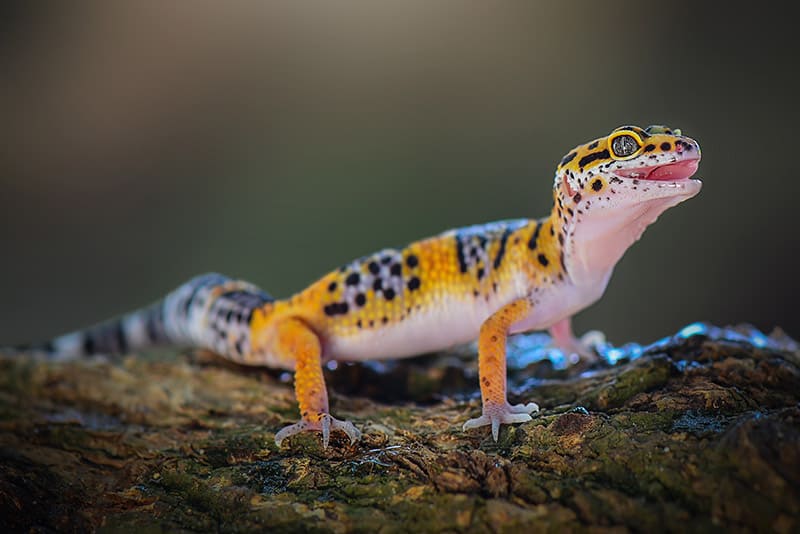
The Gekkota suborder contains all the Geckos, and is one of the largest groups of lizards. Geckos are found worldwide in all the warmer regions. The family Gekkonidae consists of 5 subfamilies, numerous genera, and at least 800 different species. What distinguishes Geckos as a family is that they have the ability to produce sounds. Some make high pitched calls, some sound like ducks, and others like barking dogs.
Most geckos have fused eyelids (like snakes) and they lick them with their protrusible notched tongue to clean them. 75% of them are nocturnal so their pupils are narrow and vertical to block out light. The rest have round pupils.
They all have flattened bodies, short necks and wide flat heads. The digits of their feet (kind of like toes) are adhesive because they have rows of tiny hooked bristles which allow them to climb straight up walls and across ceilings. Geckos are generally hardy and fairly easy to maintain in captivity. Many will also breed easily in captivity.
List of Gecko types:
- Family: Aeluroscalabotidae
- Cat Gecko – Aeluroscalabotes felinus
- Family: Diplodactylidae
- Helmeted Gecko – Diplodactylus galeatus
- Fine-faced Gecko – Diplodactylus pulcher
- Box-patterned Gecko – Diplodactylus steindachneri
- Pale-snouted Ground Gecko – Diplodactylus stenodactylus
- Tesselated Gecko – Diplodactylus tessellatus
- Eastern Stone Gecko – Diplodactylus vittatus
- Family: Eublepharidae .
- Banded Desert Gecko, Western Banded Gecko – Coleonyx variegatus
- Leopard Gecko – Eublepharis macularius
- African Fat-tailed Gecko – Hemitheconyx taylori
- Family: Gekkonidae
- Bibron’s Gecko – Pachydactylus bibronis
- Brook’s Gecko – Hemidactylus brooki
- Day Geckos – Phelsuma spp. (28 species)
- Gold Dust Day Gecko – Phelsuma laticauda
- Madagascar Day Gecko – Phelsuma madagascariensis
- Striped Day Gecko – Phelsuma lineata
- Disc-tailed Gecko – Lygodactylus picturatus
- European Leaf-toed Gecko – Phyllodactylus europaeus
- Fan-fingered Gecko – Ptyodactylus hasselquistii
- House Gecko – Hemidactylus frenatus
- Kuhl’s Gecko or Flying Gecko – Ptychozoon kuhli
- Moorish Gecko or Wall Gecko – Tarentola mauritanica
- Naked-fingered Gecko – Gymnodactylus kotschyi
- Striped Leaf Gecko, Wiegmann’s Striped Gecko – Gonatodes vittatus
- Tokay Gecko – Gekko gecko
- Turkish Gecko – Hemidactylus turcicus
- Frog-eyed Gecko, Common Wonder Gecko – Teratoscincus scincus
- Family: Pygopodidae
The Flat-footed Lizards are from Australia and New Guinea. They have serpentine-like bodies with no front legs and the back legs are nothing more that flaps. They have fused eyelids and an extensible notched tongue. Their diet consists of small lizards and invertebrates.- Burton’s Snake Lizard – Lialis burtonis
- Common Scaly-foot – Pygopus lipidopodus
Iguanas
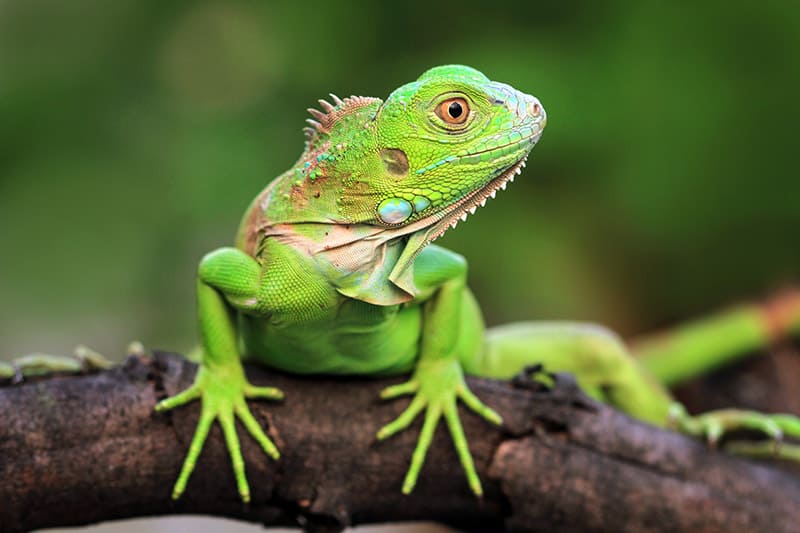
Iguanas, Anoles, Chuckwallas, Curly-tailed lizards, Swifts (Spiny Lizards), Collared Lizards (Leopard Lizard), New World (neotropical) Ground Lizards
Suborder: Iguania Family: Iguanidae
Iguanas range in type from the tree dwelling arboreal types to the terrestrial and the semi-aquatic types. They have well developed limbs and short tongues that are barely protrusible. Most have long tails, crests, and dewlaps. Males are bright and varied in coloring. Most lay eggs in the ground but there are a few who are live bearers. The desert and forest dwellers are mainly herbivores while the smaller members are insectivores or omnivores.
It had long been thought that the Gila Monsters and the Beaded lizards, in the Family Helodermatidae, were the only venomous lizards. But more recently it has been discovered that a couple other groups of lizards also contain venomous lizards including some in the Family Iguanidae, like the Green Iguana. For pet owners there is no reason for undue concern, however, as the toxin secreting glands of these lizards are smaller than those of snakes. The venom they produce may aid to subduing small prey, but on a human it would have no effect, or very little. It is said that a bitten hand might throb at most.
- Anoles
Subfamily: Polychrotinae- Green Anole (American Chameleon) – Anolis carolinensis
- Brown Anole – Anolis sagrei
- Cuban or Knight Anole – Anolis equestris
- Giant Anole – Anolis recordii
- Largeheaded Anole – Anolis cybotes
- Iguanas
Subfamily: Iguaninae- Green Iguana – Iguana iguana
- Desert Iguana – Dipsosaurus dorsalis
- Club-tail Iguana – Hoplocercus spinosus
- Fiji Island Iguana – Brackylophus spp. (2 species: fiji/tonga)
- Forest Iguana – Polychrus marmoratus
- Forest Iguana – Polychrus acuttirostris
- Galapagos Land Iguana – Conolophus subcristatus
- Galapagos Marine Iguana – Amblyrhynchus cristatus
- Rhinoceros Iguana – Cyclura corhuta
- Spiny-tail (Black) Iguana – Ctenosaura similis
- Chuckwallas
Subfamily: Iguaninae- Common Chuckwalla – Sauromalus ater
- San Esteban Island Chuckwalla – Sauromalus varius
- Curly-tailed lizards
Subfamily: Leiocephalinae
Curly-tailed lizards range from Cuba to Trinidad, and in the Caribbean. These lizards are a relatively unstudied group that were previously included in the Tropiduridae family, and regarded as subfamily, but now they are placed in their own family. There are about 28 species in one genera.- Cuban or Northern Curly-tailed Lizard – Leiocephalus carinatus
- Red-sided Curly-tailed Lizard – Leiocephalus schreibersii
- Alto Velo Curly-tailed Lizard – Leiocephalus altavelensis
- Orange-bellied Curly-tailed Lizard – Leiocephalus barahonensis
- Cuban Brown Curly-tailed Lizard – Leiocephalus cubensis
- Navassa Curly-tailed Lizard – Leiocephalus eremitus
- East Plana Curly-tailed Lizard – Leiocephalus greenwayi
- Martinique Curly-tailed Lizard – Leiocephalus herminieri
- Inagua Curly-tailed Lizard – Leiocephalus inaguae
- San Salvador Curly-tailed Lizard – Leiocephalus loxogrammus
- Hispaniolan Masked Curly-tailed Lizard – Leiocephalus personatus
- Swifts, Spiny Lizards
Subfamily: Phrynosomatinae
Spiny lizards or Swifts are common lizards ranging from Southern Canada to the Panama. They live in diverse habitats from hot, sandy deserts, prairies and sagebrush areas, to the edges of forests.- Common Swift or Fence Lizard – Sceloporus undulatus
- Horned Toad, Texas Horned Lizard – Phrynosoma cornutum
- Crevice Spiny Swift – Sceloporus poinsetti
- Granite Spiny Lizard – Sceloporus orcutti
- Mexican Emerald Swift – Sceloporus malachiticus
- Collared Lizards, Leopard Lizards
Subfamily: Crotaphytinae
Collared lizards or Leopard lizards are common lizards that live in desert habitats ranging from the southernwestern United States into northern Mexico, and then to the Panama. The are very quick moving lizards with long limbs and tail. They are carnivores and have very strong jaws. There are 12 species in 2 genera, Gambelia and Crotaphytus. They differ from each other in that the Gambelia genus has fracture planes in their tails, which allows the tail to break off if it is grabbed by a predator.- Collared Lizard – Crotaphytus collaris
- Venerable Collared Lizard – Crotaphytus antiquus
- Desert Collared Lizard – Crotaphytus bicinctores
- Grismer’s Collared Lizard – Crotaphytus grismeri
- Sonoran Collared Lizard – Crotaphytus nebrius
- Reticulated Collared Lizard – Crotaphytus reticulatus
- Baja Collared Lizard – Crotaphytus vestigium
- Cope’s Leopard Lizard – Gambelia copeii
- Blunt-nosed Leopard Lizard – Gambelia sila
- Long-nosed Leopard Lizard – Gambelia wislizenii
- New World (neotropical) Ground Lizards
Subfamily: Tropidurinae
These are New World (neo tropical) ground lizards, also called Tropidurid lizards, and are found in mainland South America. They inhabit the Amazon rainforest but also are found in more open, dry areas.- Keel-tailed Lizard – Tropidurus torquatus
Chameleons
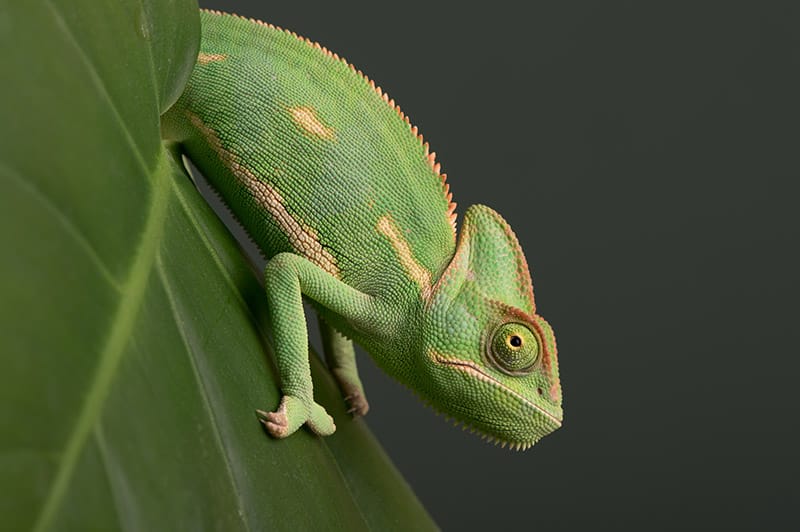
Chameleons
Suborder: Iguania
Family: Chamaeleonidae
There are approximately 160 Chameleon species from 2 subfamilies, containing 11 genera.They are found in Europe, in Asia through much of India, and in all of Africa, especially Madagascar. They are all arboreal, living in trees, and are insectivores. Some are egglayers and others are livebearers.
Chameleons have highly ridged, laterally compressed bodies, large heads, and sticky long tongues which they can accurately project at insect prey. The opposing digits of their feet are fused in groups of two or three which they use, along with their prehensile tail to move from branch to branch. They move slowly and methodically.
One of the chameleons most distinguishing features is their remarkable color changing ability. They change color depending on mood, lighting, temperature and other environmental influences. The chameleons eyes are cone shapes protruding from their head, with a small opening at the end for the pupil. The eyes move independently from each other and rotate in all directions.
- Chameleons
Subfamily: Chamaeleoninae- Common Chameleon – Chamaeleo chameleon
- Flap-neck Chameleon – Chamaeleo dilepsis
- Four Horned Chameleon – Chamaeleo quadricornus
- Jackson’s Chameleon or Three-horned Chameleon – Chamaeleo jacksoni
- Senegal Chameleon – Chamaeleo senegalensis
- Madagascan Chameleon – Chamaeleo verrucosis
- Millers Giant Chameleon – Chamaeleo melleri
- Veiled Chameleon – Chamaeleo calyptractus
- Panther Chameleon – Furcifer pardalis
- Fischer’s Chameleon – Kinyongia fischeri
- Graceful Chameleon – Chamaeleo gracilis
- Indian Chameleon – Chamaeleo zeylanicus
- Leaf Chameleons, African Leaf Chameleons
Subfamily: Brookesiinae- Dwarf Chameleon, Pygmy Leaf Chameleon – Brookesia minima
- Antsingy Leaf Chameleon – Brookesia perarmata
- Bearded Pygmy Chameleon – Rieppeleon brevicaudatus
- African leaf chameleon – Rhampholeon acuminatus
- Marshall’s Pygmy Chameleon – Rhampholeon marshalli
- Spectral Pygmy Chameleon – Rhampholeon spectrum
- Rosette-Nosed Chameleon – Rhampholeon spinosus
- Green Pygmy Chameleon – Rhampholeon viridis
Agamids
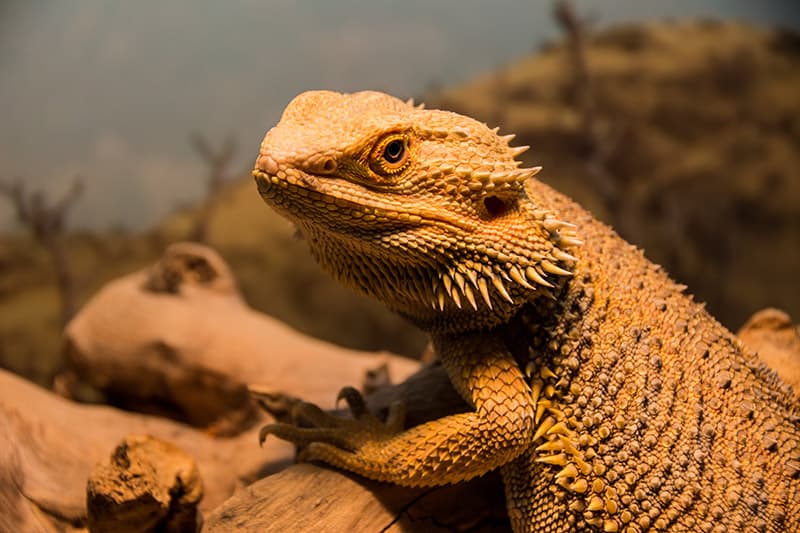
Bearded Dragons, Water Dragons, Uromastyx or Spiny-tailed lizards, Agamas, Sailfin Lizards, and Butterfly Lizards
Suborder: Iguania
Family: Agamidae
Agamas are Old world arboreal lizards consisting of 300+ species, within 6 generally recognized subfamiles. These lizards are considered the “Old World” equivalent of the Iguanidae family because they are found on the “old world” continents of Africa, Asia, and Australia. Another similarity to the iguanidae is that they come in the terrestrial, arboreal, and semi-aquatic types. The 6 subfamiles include:
- Agaminae (Africa, Asia and Australia)
- Amphibolurinae (Australia and New Guinea)
- Draconinae (South and Southeast Asia)
- Hydrosaurinae (Hydrosaurus, Papua New Guinea, Philippines, and Indonesia)
- Leiolepidinae (Leiolepis, Southeast Asia)
- Uromasticinae (Saara and Uromastyx, Africa and south Asia)
Agamids have well developed limbs, long tails, and often bizarre forms with crest, dewlaps and expandable appendages. The males are often brightly colored. Many will breed easily in captivity, laying soft-shelled eggs in ground burrows.
It had long been thought that the Gila Monsters and the Beaded lizards, in the Family Helodermatidae, were the only venomous lizards. But more recently it has been discovered that a couple other groups of lizards also contain venomous lizards including some in the Family Agamidae, like the Bearded Dragon. For pet owners there is no reason for undue concern, however, as the toxin secreting glands of these lizards are smaller than those of snakes. The venom they produce may aid to subduing small prey, but on a human it would have no effect, or very little. It is said that a bitten hand might throb at most.
- Bearded Dragons
Subfamily: Agaminae- Bearded Dragon (Inland) – Pogona vetticeps
- Bearded Dragon – Pogona barbata
- Dwarf Bearded Dragon – Pogona minor
- Lawson’s or Rankin’s Bearded Dragon – Pogona henrylawsoni
- North-west Bearded Dragon – Pogona mitchelli
- Nullarbor Bearded Dragon – Pogona nullarbor
- Western Bearded Dragon – Pogona minima
- Water Dragons
Subfamily: Agaminae- Chinese water dragon – Physignathus cocincinus
- Australian water dragon – Physignathus lesueurii
- Uromastyx, Spiny-tailed lizards
Subfamily: Uromasticinae- Spiny-tailed Agama, Black Thorny-tailed Agama, Bell’s Dabb Lizard – Uromastyx acanthinurus
- Egyptian Thorny-tailed Agama, Egyptian Mastigure, Leptien’s Mastigure – Uromastyx aegyptius
- Spiny-tailed Lizard – Uromastyx flavifasciata
- Saharan Uromastyx, Saharan Spiny-tailed Lizard – Uromastyx geyri
- Indian Spiny-tailed Lizard, Indian Thorny-tailed Agama, Hardwick’s Spiny-tailed Lizard – Uromastyx hardwickii
- Agamas
Subfamily: Agaminae- Red-headed Agama, Rainbow Lizard – Agama agama
- Blue-throated Agama – Agama atricollis
- Ground Agama, South African Agama – Agama aculeata
- Desert Agama – Agama mutabilis
- Pyramid Agama, Hardun Agama, Common Agama- Agama stellio
- Toad Head Agama – Agama savgney
- Other Agamas
Subfamily: Agaminae- Frill-necked Lizard – Chlamydosaurus kingii
- Green Tree Lizard – Acanthosaura capra
- Mountain-horned Lizard – Acanthosaura armato
- Sawback Agama – Calotes calotes
- Bornean Bloodsucker – Calotes cristellatus
- Garden Tree Lizard, Indian Bloodsucker – Calotes versicolor
- Sailfin Lizards Subfamily: Hydrosaurinae
- Philippine Sailfin – Hydrosaurus pustulatus
- Soa Soa, Lassara Sailfin – Hydrosaurus amboinensis
- Weber’s Sailfin Lizard – Hydrosaurus weber
- Butterfly Lizards
Subfamily: Leiolepidinae- Bell’s Agama, Common Butterfly Lizard – Leiolepis belliana
- Butterfly Lizard, Spotted Butterfly Lizard – Leiolepis guttata
- Ngo Van Tri’s Lady Butterfly Lizard – Leiolepis ngovantrii
Basilisks
Basilisks, Helmet lizards, or Collared Lizards
Suborder: Iguania
Family: Iguanidae
Subfamily: Corytophaninae
Collared lizards, Helmeted lizards, and Basilisks have well developed head crests, typically in the shape of a helmet. They inhabit forested areas and range from Mexico as far south as Ecuador. Until recently, these lizards were included in the family Iguanidae. Now they have a family of their own, consisting of 3 genera and about 9 known species. These lizards are also considered a “New World” family because they are found on the continent of North America in Central America, starting in Cost Rico and Panama and Costa, southward into Columbia on the continent of South America.
- Basilisks
The basilisks are slender lizards with well developed limbs that are fairly long. They have a helmet-like head crest and a sail-like erectable crest that runs down their back.They are arboreal and semi-aquatic. Being omnivorous they require both vegetable matter and proteins. Many will breed in captivity, laying eggs in ground burrows.- Helmeted Basilisk, Common Basilisk – Basiliscus basiliscus
- Green Basilisk, Plumed Basilisk, Double-Crested Basilisk – Basiliscus plumifrons
- Red-headed Basilisk – Basiliscus galeritus
- Brown or Striped Basilisk – Basiliscus vittatus
- Serrated Casquehead Iguana – Laemanctus serratus
- Helmet lizards, Collared Lizards
- Helmeted Iguana – Corytophanes cristatus
- Guatemalan Helmeted Basilisk – Corytophanes percarinatus
- Hernandez’s Helmeted Basilisk – Corytophanes hernandezi
- Eastern Casquehead Iguana – Laemanctus longipes
Skinks
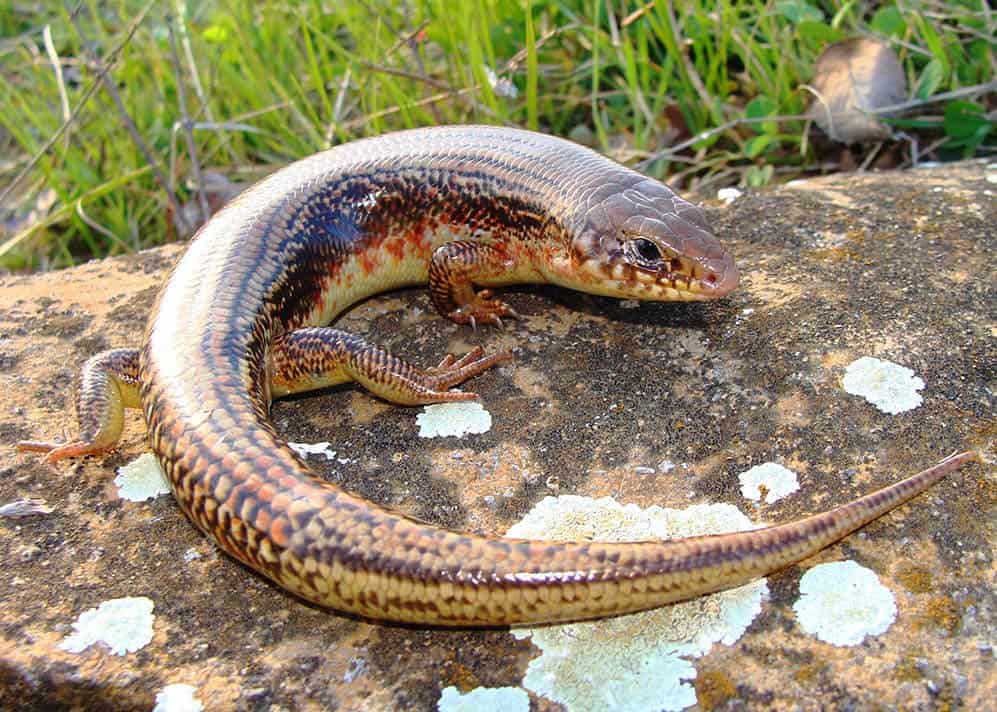
Skinks
Suborder: Autarchoglossa
Family; Scincidae
Family: Scincidae
Skinks consist of about 1200 described species in many genera, and many are being re-classified. They are very widespread and found on six continents; Africa, Asia, Australia, Europe, North America and South America. The Autarchoglossa Suborder and family groupings are under scrutiny, but until a re-ordering has been agreed upon by the experts, we will use the traditional groupings.
- Skinks
Skinks are terrestrial and often burrowers. Their diet consisting mostly of insects though some are omnivorous. Skinks have elongated and rather circular bodies. They have little necks with small pointed heads. Their legs are short, even absent on some species, and their tails vary from short to long and are generally colorful. Many skinks will breed fairly easily in captivity. Some are livebearers and some are egglayers.- African Five-lined Skink, Rainbow Rock Skink – Mabuya quinquelaeniata
- Apocathary Skink – Scincus scinscus
- Berber SKink, Desert Skink – Eumeces algeriensis
- Blue-tongued Skink – Tiliqua scincoides
- Cunningham’s Skink – Egernia cunninghami
- Eyed Skink, Ocellated skink – Chalcides ocellatus
- Five-lined Skink – Eumeces faciatus
- Great Plains Skink – Eumeces obsoletus
- Green Tree Skink – Dosia smaragdinum
- Pinecone Skink, Shingleback Skink – Trachydosaurus rugosus
- Snake-eyed Skink – Ablepharus kitaibeli
- Solomans Giant Skink – Corucia zebrata
- Striped Skink – Mabuya striata
- Limbless Skinks
This is a little known family that consists of a single genus with only about 5 species. They are found in central Africa. They are wormlike and limbless, living in loose soil and leaf matter, possibly eating termites.
Not known to be held in captivity.- Limbless Skinks – Feylinia spp.
Tegus and Greaved Lizards
Tegus and Greaved Lizards, Whiptails, Ground Lizards, Ameivas, New World Runners, and Racerunners.
Suborder: Autarchoglossa
Family: Teiidae
The Teiidae family has approximately 400 species in about 40 genera. They can be found in North America and South America, specifically in the United States, central America, south and central Argentina, and Chile. The Autarchoglossa Suborder and family groupings are under scrutiny, but until a re-ordering has been agreed upon by the experts, we will use the traditional groupings.
The terrain of the Teiidea lizards varies from tree dwelling to desert dwelling, with some types being limbless burrowers. For the most part, they have well developed limbs, long tails, large plate like heads, and an extensible forked tongue. In their diet, the Teiidae family varies from being carnivorous to partly or mostly herbivorous. Because of their nervous nature, they don’t always do real well in captivity, and are sparse breeders.
- Tegus and Greaved Lizards
- Ameiva – Ameiva ameiva
- Black and White Tegu – Tupinambis teguixin
- Golden Tegu – Tupinambis nigropunctatus
- Red Tegu – Tupinambis rufescens
- Jungle Runner – Cnemidophorus lemniscatus
- Six-lined Racerunner – Cnemidophorus sexlineatus
Monitor Lizards
Monitor Lizards.
Suborder: Autarchoglossa
Family: Varanidae
The Varanidae family has over 70 species in 1 genera, with at least 62 species currently described. The Monitor lizards are found in Australia and the neighboring islands of Asia. Most of these are fairly large ground dwelling lizards and all are carnivorous.
Monitors have well developed limbs and a long whiplike tail. They have an elongated body topped of with a long head and pointed snout. The monitors jaws are very, very powerful. Many species do well in captivity, but successful breeding is pretty rare.
- Monitor Lizards
- Australian Monitor – Varanus giganteus
- Australian Ridge-tailed Monitor – Varanus acanthurus
- Black Rough-necked Monitor – Varanus rudicollis
- Black Tree Monitor – Varanus beccarii
- Bogert’s Monitor – Varanus bogerti
- Blue-tailed Monitor – Varanus doreanus
- Crocodile or Papuan Monitor – Varanus salvadorii
- Dumeril’s Monitor – Varanus dumerilii
- Gould’s Monitor – Varanus gouldi
- Green Tree or Emerald Monitor – Varanus prasinus
- Irian Jayan Peach-throated Monitor – Varanus jobiensis
- Komodo Dragon – Varanidae komodoensis
- Mangrove Monitor – Varanus indicus
- Nile Monitor, Ornate Nile Monitor – Varanus niloticus
- Pygmy Mulga Monitor – Varanus gilleni
- Rusty Monitor – Varanus kingorum
- Salvator Monitor or Asian Water Monitor – Varanus salvator
- Savannah Monitor – Varanus exanthematicus
- Southern Argus Monitor – Varanus panoptes rubidus
- Spiny-tailed Monitor – Varanus acanthurus
- Storr’s Monitor – Varanus storri
- Timor Monitor – Varanus timorensis
- White-throated Monitor – Varanus albigularis
Earless Monitor
Earless Monitor Lizard
Suborder: Autarchoglossa
Family: Lanthanotidae
The family Lanthanotidae consists of a single species. The Earless Monitor Lizard is found only in north-west Borneo. It has an elongated body, short blunt tail, a broad flat head on a thick neck and no external ear openings.
It is found around waterways and has been known to eat raw strips of fish in captivity.
- Earless Monitor Lizard
- Bornean Earless Monitor – Lanthanotus borneensis
Typical Lizards
Typical Lizards, Wall lizards, True lizards, Lacertas, Lacertid Lizards, Old World Runners
Suborder: Autarchoglossa
Family: Lacertidae
The Lacertidae family are “Old World” typical lizards from the continents of Africa, Europe and Asia. This family contains hundreds of species in 37 genera. The Autarchoglossa Suborder and family groupings are under scrutiny, as well as genus and species, but until a re-ordering has been agreed upon by the experts, we will use previous groupings and names.
The Typical Lizards are distinguished by a collar of large scales on the underside of their necks. Most of their other physical characteristics can be described by “long” and “thin”. They have slender elongated bodies with a well defined head above a narrow neck, a long extendable tongue that is deeply forked, a long slender tail that can be shed, and thin toes.
Typical lizards are hardy and easily kept in captivity though they move very quickly. The structure of their tail supports fast zigzag movements and very accurate jumps that are needed to catch their insect prey. They are all insectivores. Many will breed easily in captivity. Most are egglayers though some give live birth.
- Typical Lizards, Wall lizards, Lacertid Lizards
Subfamily: Gallotiinae- Algerian Sand Lizard – Psammodrumus algirus
- Typical Lizards, Wall lizards, Lacertid Lizards
Subfamily: Lacertinae- Spiny-footed Lizard – Acanthodactylus erythrurus
- Dwarf Keeled Lizard – Algyroides fitzingeri
- Emerald Lizard or European Green Lizard – Lacerta viridis
- Eyed Lizard, Foot lizard, or Ocellated Lizard – Lacerta lepida
- Greek Wall Lizard or Greek Rock Lizard – Lacerta graeca
- Sand Lizard or Mongolian Lacerata – Lacerta agilis
- Turkish Rock Lacerata – Lacerta saxicola
- Viviparous Lizard – Lacerta vivipara
- Ukrainian Lacerata – Podarcis taurica
- Ruins Lizard – Podarcis sicula
- Wall Lizard – Podarcis muralis
- Lilford’s Wall Lizard – Podarcis lilfordi
- Ibiza Wall Lizard – Podarcis pityusensis
Girdled Lizards
Girdled Lizards, Girdle-tailed Lizards, Spinytail Lizards, Grass lizards
Suborder: Autarchoglossa
Family: Cordylidae
The Family: Cordylidae, Girdle-tailed Lizards, consists of about 71 species in 4 genera. They are found in Africa southeast of the Sahara and in Madagascar. These lizards inhabit mostly rocky areas, though one species digs burrows. They are mostly insectivores.
The Girdled lizards have flattened heads and bodies with enlarged rectangular scales, arranged in regular rows around the body like girdles, and they are typically spiny. Their namesake, derived from rings of spines on the tail, are used to wedge themselves into rocky crevices and to ward off predators. Many do well in captivity and can be bred, most of the Girdled Lizards give live birth.
- Girdled Lizards
Subfamily: Cordylinae- Common Sungazer – Cordylus cordylus
- Giant Zonare, Sungazer, Girdled Lizard, or Girdle-tailed Lizard – Cordylus giganteus
- Jones Armadillo Lizard – Cordylus tropidosternum
- Ornamental Flat Lizard – Platysaurus guttatus
- Grass Lizards
Subfamily: Chamaesaurinae
The Grass lizards differ from the other Cordylidae lizards in that they are almost entirely limbless. They have tiny spikes in place of the hind limbs.
Plated Lizards
Plated Lizards
Suborder: Autarchoglossa
Family: Gerrhosauridae
The Family Gerrhosauridae, Plated Lizards, consists of about 34 species in 6 genera. They are found in Africa southeast of the Sahara and in Madagascar. These lizards inhabit a range of habitats from rocky areas to sand dunes. They are variable in form. Some species have four fully developed limbs while others with very reduced remnants of hind limbs. They are mostly carnivorous. Many do well in captivity and can be bred, most of the Plated Lizards lay eggs.
- Plated Lizards
Subfamily: Gerrhosaurinae- Sudan Plated Lizard – Gerrhosaurus major
- Ornate Giant Sudan Plated Lizard – Gerrhosaurus nigrolineatus
- Yellow-throated Plated Lizard – Gerrhosaurus validus
- Keel Plated Lizards
Subfamily: Zonosaurinae- Madagascar Giant Plated Lizard – Zonosaurus maximus
Alligator Lizards
Alligator Lizards, Anguid Lizards, Galliwasps, Slowworms, Blindworms, Glass Lizards
Suborder: Autarchoglossa
Family: Anguidae
The family Anguidae (Alligator Lizards, Anguid Lizards, Galliwasps, Slow Worms, Blind Worms, Glass Lizards) consists of 94 species in 3 subfamilies and 9+ genera. They are found in the norhthern hemisphere. They inhabit a wide range of habitats and though most are terrestrial, some climb trees.
All of the Anguidae family have elongated bodies and long tails that they can shed. Their limbs are very slight or often gone, giving them a snake like appearance. However, their moveable eyelids betray them as lizards. A snakes eyelids are fused. They have either a notched or forked tongue and are either insectivores or carnivores.
- Slow Worms, Glass lizards
Subfamily: Anguinae- Slowworm or Blindworm – Anguis fragilis
- Glass Snake or Scheltopusik – Ophisaurus apodus
- Alligator lizards
Subfamily: Gerrhonotinae- Green Arboreal Alligator Lizard – Abronia Graminea
- Southern Alligator Lizard – Gerrhonotus multicarinatus
Night Lizards
Night Lizards
Suborder: Autarchoglossa
Family: Xantusiidae
The family Xantusiidae has approximately 23 living species in 3 genera. The Night Lizards are found in semi-desert environments in North America, specifically lower California, central America and in the West Indies. They have fused eyelids and short tongues that do not protrude. They are nocturnal and carnivorous.
- Night Lizards
- Granite Night Lizard – Xantusia henshawi
- Desert Night Lizard, Yuccan Night Lizard – Xantusia vigilis
Crocodile Lizards
Crocodile Lizards, Strange Lizards, Knob-scaled lizards
Suborder: Autarchoglossa
Family: Xenosauridae
The family Xenosauridae has about 5 species in 2 genera.
- Crocodile Lizard
The Crocodile Lizard of the Shinisaurus genus is found in Asia, specifically China in the Hunan, Guangxi Zhuang, and Guizhou provinces. The Crocodile Lizard has well developed limbs and a muscular tail patterned with light and dark bands. Its name is derived from the bony scales running along its back and tail, giving it a crocodile-like appearance though it is much smaller than actual crocodiles, only reaching 16 – 18 inches (40-46 cm) in length. The crocodile lizard is semi-aquatic, living in shallow waters or on overhanging branches and leaves. It eats fish and aquatic invertebrates like tadpoles and snails, as well as insects. It is not known to be kept in captivity.- Crocodile Lizard, Chinese Crocodile Lizard – Shinisaurus crocodilurus
- Strange Lizards, Knob-scaled Lizards
The Strange Lizards of the Xenosaurus genus, also called Knob-scaled Lizards, are found in North America, specifically central and southern Mexico. Their habitat ranges from moist semi-aquatic areas to semi-arid scrub areas. They also have well developed limbs. The strange lizard is primarily insectivorous and gives live birth to its young.- Newman’s Knob-scaled Lizard – Xenosaurus newmanorum
- Flathead Knob-scaled Lizard – Xenosaurus platyceps
- Pena’s Knob-scaled Lizard – Xenosaurus penai
- Pallid Knob-scaled Lizard – Xenosaurus rectocollaris
Venomous Lizards
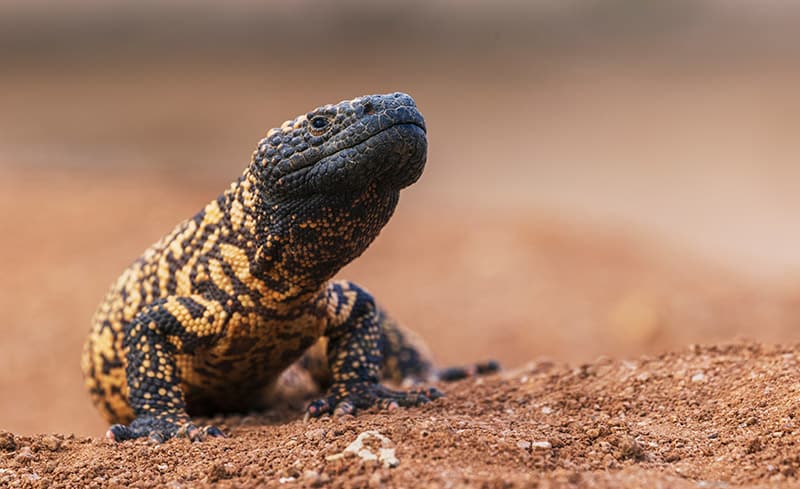
Venomous Lizards, the Gila Monsters and Beaded Lizards
Suborder: Autarchoglossa
Family: Helodermatidae
The Family Helodermatidae contains venomous lizards, the Gila Monsters and the Beaded Lizards. There are just 2 described species in 1 genera, and there are a few suggested subspecies. They are found in North America, specifically in south-western United States and Mexico. They have a stout body with a broad head, well developed limbs, a short fat tail, and they are carnivorous.
- Venomous Lizards
- Gila Monster – Heloderma suspectum
- Beaded Lizard – Heloderma horridum
Burrowing Lizards
Burrowing Lizards
Suborder: Sauria
Family: Dibamidae
The Family Dibamidae contains about 22 species in 2 genera. The Burrowing Lizards are a family of legless lizards found in Mexico and the tropical forests of Southeast Asia, Indonesia, the Philippine Islands and western New Guinea. They are wormlike with eye and ear openings that are covered with skin, and they burrow.
- Burrowing Lizards
- Old World Burrowing Lizards – Dibamus spp.
These are found in southeast Asia and New Guinea. They are wormlike with no limbs, though there are stumps on the males. Their eye and ear openings are covered with skin and they burrow. These lizards are rarely kept in captivity. - Mexican Burrowing Lizard, Mexican Blind Lizard – Anelytropsis papillosus
This is a single species found in North America, specifically central Mexico. It has a wormlike body and skin covered eyes and ears. It is not known to have been kept in captivity.
- Old World Burrowing Lizards – Dibamus spp.
Burrowing Slow Worms
Burrowing Slow Worms
Suborder: Sauria
Family: Anniellidae
The Family Anniellidae is a small group that consists of a single genus and 2 species. The Burrowing Slow Worms are found in North America, specifically in central and coastal California in the United States. They have small limbless bodies, small eyes, no obvious ears and a forked tongue. They eat invertebrates. They are not known to be held in captivity.
- Burrowing Slow Worms
- California Legless Lizard – Anniella pulchra
- Baja California Legless Lizard – Anniella geronimensis
Featured Image Credit: Lauren Suryanata, Shutterstock
